
268 apprehended for improper disposal of garbage

268 persons have been arrested for the disposal of garbage haphazardly in the Western Province. They were taken into custody during raids carried out on the 28th and 29th of last month.
The highest number taken into custody was from the Mount Lavinia division. It was around 60. 48 have been taken into custody from the Colombo North area. The number arrested from Colombo Central was 27.
A total of 41 have been apprehended from the Colombo South area for improper disposal of garbage. Also 39 persons have been rounded up from the Nugegoda Division, while 37 persons have been taken into custody from the Gamapha Division.
The Police Headquarters reported that individuals who had been engaged in the illegal disposal of garbage from the Kelaniya and Negombo Division have also been taken into custody. Cases will be filed against these persons by the respective Police Stations. The Police emphasized that they will continue to carry out such raids.
Source – 01/08/2017, ITN, See more at – http://www.itnnews.lk/local-news/268-apprehended-for-improper-disposal-of-garbage/

Consciousness can impact action,’ leading the way for a new normal in swimwear and resortwear fashion


- Multidisciplinary expert discussion at TrendSwim presented by Swim Week Colombo
The second session of TrendSwim focused on ‘Good and Sustainable Fashion – Earth Conscious Future’. With the exponential growth in the global swimwear market, trends are changing at a faster pace than ever. TrendSwim’s first session focused on the key aspects surrounding this rapidly-evolving industry. The second session focuses on good and sustainable fashion, building an earth conscious future, sustainability practices and industry perspective.
Speakers were Ajai Vir Singh, President/Founder of Colombo Fashion Week, Designer for Conscience; Sarinda Unamboowe, CEO/Managing Director at MAS Kreeda; David Abraham, Creative Director, Abraham and Thakore, design resources for fashion, accessories and home textile products; Shiranee E. Yasaratne, Advisor to Bio Diversity Sri Lanka; and Anoma Wijewardene, Artist.
Following are excerpts:
Q: Ajai, this is the third edition of swim week and the second TrendSwim discussions. But you have a stronger, deeper commitment to this year’s Swim Week. You’ve discussed about wanting to create a new normal in design and manufacturing of the fashion industry here. What is the difference and what’s your vision for swim week going forward?
Ajai: The statistics associated with the apparel industry are staggering. Beginning 15 years ago with the Garments without Guilt campaign. Policing does not work, while the research is available, a conscious change of heart is required in order to create this new normal. All designers showcasing this year have a green impact story which will be created into an awareness campaign. If you can change the heart, make it greener, the impacts will be viable. We intend to create a platform which is an ecosystem for fashion and apparel in Sri Lanka – designers, manufacturers, suppliers who all share the same vision. If we start now, in five years or so, the results will be visible.
Q: Recently I was reading that we need to move from just being sustainable to being regenerative. It seems as if MAS is trying to do just that. Can you tell us a little bit about the macro large scale efforts that MAS is spearheading and how it has also become possible to do this?
Sarinda: Our industry is one of the biggest polluters in the industry and if action is not taken now to mitigate these impacts, the repercussions will be catastrophic. Even as designers, try and utilise as much of the fabric as possible. What we don’t consider is the amount of waste which adds to landfills. Be conscious of your waste produced.
Recently, MAS has tied up with the Biyagama zone to implement a material recovery centre. A collection point for separation – fabric, perishable waste, etc. will be separated and incinerated as necessary and recycle what can be. Innovations have allowed to produce yarn from recycled fabrics. We have also begun mining existing landfills to reduce and plant a green cover over it
The SL Navy shredders are collecting marine pollution which is crushed and brought to a company which produces yarn, currently used in paint brushes but will be made into fabric in the very near future in the island itself.
Sustainable fabric is no longer an unaffordable commodity. Commercially viable fabrics now exist which can be created 100% recyclable fabrics. MAS occupies a large acreage of land in Sri Lanka, all the roofs are being converted to solar roofs within the next two years. For every acre, 1:10 and then 1:100 reforestation by 2025.
Q: Can you give us an overall view of how Sri Lanka as a whole is responding to the environment, climate, social sustainability agenda?
Shiranee: Over the years, people’s perception of environmentalists have changed. The private sector is now volunteering. Biodiversity financing study looking at the amount of financing that the State is putting into conservation. There is no enabling environment for biodiversity conservation in Sri Lanka despite being a world biodiversity hotspot.
Although we work with high end companies who already established environmental responsibility.
70% of industry are SMEs which don’t understand the impact of environmental responsibility. Therefore, it is necessary to handhold these companies to guide them in the right direction.
Q: We have been talking largely about ecological and environmental aspects. But our footprint, our impact is much more complex. It’s social and cultural too. You want to preserve and nurture your cultural heritage. Your design and fashion philosophy is built around classicalism rather than being trendy. You want to create fashion that lasts than are short lived. How does this speak to the sustainability agenda?
David: The quicker, shorter and more wasteful the consumption cycle is, we are not going to be sustainable. We try to incorporate longevity and quality to make a product last longer. Lower quality is associated with faster, cheaper fashion. We work with small craftspeople and look at the cultural aspect of sustainability. I think it is imperative that we sustain these livelihoods and make better the living situation of the craftspeople by ensuring sustain of their craft. Sustainability has a very wide definition.
Q: How do you see the claims made by some, that big fashion brands are guilty of cultural misappropriation?
David: Capitalises ideas from everywhere and anywhere without much conscience. It is interesting that people are more aware of this. One of the key ingredients of fashion is the cannibalism of ideas. We live in a time where ideas spread within seconds. Ideas are shifting. Enforcement may not be possible but important that these issues are raised, addressed and acknowledged by the large brands. Creation does not have a geographic or political boundary. We are well within a digital space which inspires everything around us.
Q: So I am going to ask the simple question… in times like these, how can art save us? Or how is art saving you?
Anoma: I’ve used poetry, art, books I’ve read in the past, what people have been talking about for years, celebrating nature. Accept that we are fundamentally a part of nature and we are not able to see this and associate ourselves with it, and so we continue to degrade and destroy the environment because of human greed, remind ourselves that we are nature and we destroy ourselves if we carry on this path. It is my passion to get this to people and to move and inspire people to change their hearts. Diversity in collaboration to celebrate and love nature.
Source – 02/08/2017, DailyFT, See more at – http://www.ft.lk/article/632741/%E2%80%98Consciousness-can-impact-action—leading-the-way-for-a-new-normal-in-swimwear-and-resortwear-fashion

Myanmar gifts a Tusker
A tusker has been gifted by former President of Myanmar Thein Sein to President Maithripala Sirisena, Diyawadana Nilame Pradeep Nilanga Dela told Ceylon Today.
The tusker has already been shipped out from Myanmar and will be arriving in Sri Lanka soon.
The Nilame also said that the tusker will take part in next year’s Kandy Esala Perahera, as there is not enough time for it to participate in this year’s Kandy Esala Perahera. (RJ)
Source – 03/08/2017, Ceylon Today, See more at – http://www.ceylontoday.lk/article20170401CT20170930.php?id=5908

Public urged to boycott polythene and help traditional bag weavers
Cottage industries of Sri Lanka will need time to catch up with demand for shopping bags made of natural materials when the ban on polythene bags and polystyrene containers becomes effective in September despite protests by manufacturers.
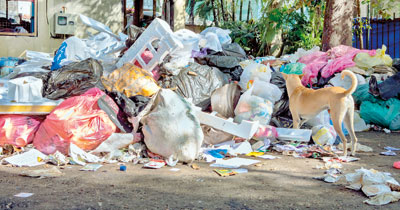
City garbage mostly consists of polythene. Pic by Sameera Weerasekera
Households are also being encouraged to boycott polythene bags for the sake of freeing Sri Lanka from the non-biodegradable garbage mountains nightmare.
There are those who already use reusable cotton tote bags for their shopping, but they are few. Colourful handloom bags are also available.
People are also being urged to use re-usable lunch boxes and banana leaves when they can.
The Central Environment Authority insists that the ban will be imposed this time on polythene lunch sheets, grocery bags, shopping bags and polystyrene food containers. It has failed on several previous occasions.
Waste Management (Plastics), Director, Ajith Weerasundera said there will be no phase out period. “The ban has been approved by the cabinet and will be implemented on 1st September,’’ he said.
Statistics reveal 27% of the garbage collected from households contain polythene and polystyrene products.
On two occasions, the CEA tried to ban polythene – once in 2007 when Maithripala Sirisena was Minister of Environment. The law was never implemented. Again in December 2015, after Mr Sirisena became President, he tried to revive the law and failed.
Meanwhile, leading supermarkets, shops and retail outlets have been generously handing out polythene shopping bags. Vendors at wet markets are also liberally providing polythene bags – even for a single papaya, or a bunch of plantains. But alternatives are available.
The head of the Field Ornithology Group of Sri Lanka, Professor Sarath Kotagama said: “Discourage the consumer from using the product and the businesses will stop production. There are always alternatives – we should take our own traditional ‘malla’ for shopping.’’
He said waste paper should be used to make grocery bags.
“If third world countries including Bangladesh and Nigeria have done it we can do it. We need polythene only for items that have a shelf life,’’ he said. Also it is important that biodegradable, reusable and photo-degradable material are used to wrap food. “This way we can push out non-biodegradable polythene/polystyrene from our markets.’’
He added: “Consumer resistance is crucial. They can give the message to manufacturers by boycotting polythene and polystyrene products. When consumer consumption patterns change the manufacturers will change, too.’’
But traditional reed, jute and palmyrah industries are not yet ready to provide alternative products for shopping and packaging. Many of the cottage industries need support, specially from the state. The lack of demand and high costs have also affected the traditional reed products industry.
A study done by the Ruhuna University in the Kalutara District revealed that most people owned enough land for reed cultivation and 65% of the women had the technical knowledge to make reed products including shopping bags and baskets. The study also recommended diversification to revitalise the industry that could bring quality products into the market.
The palmyrah industry which could step in is largely confined to the northern region. A study by the Hector Kobbekaduwa Agrarian Research and Training Institute on palmyrah products found that it could fill only around 2% of the void created by the polythene and polystyrene ban.
Additional Director, R L M Jayatissa said the industry was underprepared. “It is a cottage based industry it would take time to take over,’’ he said.
However CEA’s, Weerasundera sounded positive and said these industries are being looked at with a plan to revive them. He suggested that people use lunch boxes and banana leaves instead of lunch sheets and also use traditional bags for shopping.
Source – 30/07/2017, The Sunda Times, see more at – http://www.sundaytimes.lk/170730/news/public-urged-to-boycott-polythene-and-help-traditional-bag-weavers-252506.html

Fishing net may have killed dugong and calf
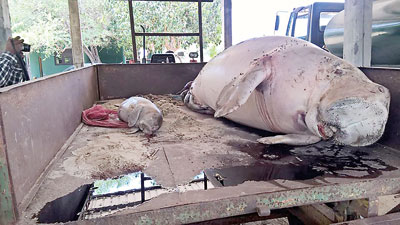
Wildlife offcials suspect that the carcass of a female dugong found afloat in the northern seas off Mollikulam on Thursday July 27 with a new-born calf may have been drowned after being trapped in a fishing net.
Dr Sevvandi Jayakody of the Department of Aquaculture and Fisheries of the Wayamba University, said that the female was over seven feet in length and the calf was about three-and-a-half feet in length and well developed. She said she was saddened.
Dr Lakshman Peiris of the Department of Wildlife, said the aminals may have died of suffocation after they had been snared in a fishing net.
The dugong needs to surface to breathe from time to time. If one gets entangled in a net it would not be able to to breathe. In this instance, the mother may have aborted the baby.
Dugong (dugong dugon) known as ‘Muhudu Ura’ in Sinhala, is considered to be ‘critically endangered’ in Sri Lankan waters. They are seen only in the Gulf of Mannar and Palk Bay area in the northern ocean. They are protected by law, but a number of dugongs get killed every year. Dynamite fishing is a major threat, while other fishing gear such as gill nets are death traps. Last year, at least 13 dugongs were killed.
Ocean Resources Conservation Association, reports that another dugong was killed last month in Pukkulum, Wilpattu.
A project funded by Global Environment Fund Project and Mohamed bin Zayed Species Conservation Fund with management of the United Nations Environment Programme is carrying out ground work to help protect dugongs. Experts are surveying the dugong habitat to identify a protected.
Sri Lanka is also a signatory of the memorandum of understanding on the Conservation and Management of Dugongs and their Habitats throughout their range (Dugong MoU) of the Convention on Migratory Species.
Source – 30/07/2017, The Sunday Times, see more at – http://www.sundaytimes.lk/170730/news/fishing-net-may-have-killed-dugong-and-calf-252575.html
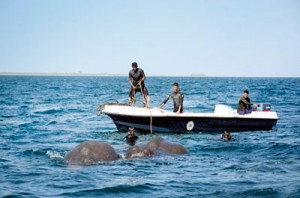
Ocean-going jumbos possibly disoriented
Wildlife experts have not been able to adequately explain why a few elephants had been sighted in distress in the oceans closer to shore in the east and even in the deep seas. Some suspect they had been disoriented. Elephants are known to be able to negotiate lakes, reservoirs and rivers. Once again, this week, the navy helped to rescue two elephants seen in the waters off Trincomalee.
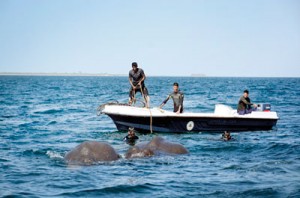
The rescue operation in progress
They had been detected by sailors on a patrol boat about one kilometre from shore near Round Island at about 6:30 am onSunday, July 30. A team of divers and three more fast attack craft were called in to guide the jumbos back to land. The divers secured a rope around the elephants to help drag them to shore.
The Department of Wildlife Conservation Trinco range office was also alerted to the incident. Around 11:40 am, the two elephants reached the shallow waters around Foul Point in Trincomalee. From there, the wildlife team took control and drove the elephants back to a nearby forest patch.
Trincomalee wildlife range officer, K A Srimal, said they were two young elephants and appeared to be in good health. Two weeks ago, the navy helped to pull to shore another elephant which had gone swimming.
On July 11, a lookout aboard a Dvora patrol craft saw an object about 8 nautical miles offshore from Kokkuthuduwai in Kokilai at about 9:00am, Lieutenant Commander MBC Perera later recalled. It turned out to be an elephant in distress. The rescue was complicated and dangerous and it took nearly 12 hours, ending only at late at night.
He recalled heavy rains at the time and rough seas.
Divers called to the scene took major risks trying to wrap a rope around the belly of the beast to help pull it to shore, slowly. Videos show that the creature appeared spent from struggling against strong currents and could not react aggressively to the human presence.
A navy diver did however recalled being struck by the struggling elephant’s foot and being pushed 10 feet under water as he attempted to cast a rope around the animal. It was about 4:00pmwhen the sailors began to haul the animal, stopping on occasions to allow it to catch up. When they reached the shallows, it was7:30 pm. Wildlife officers came in to help once the creature walked on to shore. The elephant was chased back in into the forest around Pulmuddai.
Wildlife ranger Mr Srimal said elephants had been seen in inland reservoirs such as Gal Oya, Udawalawe, and Maduru Oya.
There are also historical accounts of jumbos swimming on to islands in Trincomalee from the mainland.
Howard Martenstyn remembers seeing a swimming pachyderm back in the 1960s when one swam to Elephant Island from the Trinco dockyard area. Elephant researcher Dr Prithiviraj Fernando suspects that the elephant seen far from shore in the deep seas may have been disoriented and was dragged away by a strong ocean current.
He also remembers that in 2010, an elephant was seen in the seas near Norway Island off Sampur. It has been a translocated animal and had a radio collar. Dr Fernando believes it ended up in the sea in an attempt to find its way back to home. The elephant, named ‘Brigadier’ was found dead, later, having fallen into an abandoned agro-well.
source – 30/07/2017, The Sunday times, see more at – http://www.sundaytimes.lk/170730/news/ocean-going-jumbos-possibly-disoriented-252509.html

Over 1.mn people hit by drought: DMC
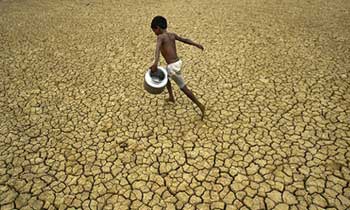
The total number of people affected by the prevailing drought had increased over one million, the Disaster Management Centre (DMC) census said today.
The DMC said that eight provinces out of the nine, where people in 17 districts were hit by the drought.
According to the DMC latest situation report 1, 093, 717 people belonging to 314, 049 families had been severely affected by the prevailing drought.
The Northern Province is the most affected Province with a total of 462, 815 individuals belonging to 133, 678 families being hit by the drought.
The North-Western Province and the Eastern Province followed with a total 281, 013 people belonging to 82, 513 families and 211, 736 people belonging to 59, 003 families respectively.
In the Kurunegala District 149, 962 individuals belonging to 45, 730 families were affected by the drought.
Meanwhile, 79, 602 people belonging to 23, 285 families in the North-Central, 20, 641 people belonging to 5, 904 families in the Central Province, 29, 868 people belonging to 7, 668 families in the Uva Province, 812 people belonging to 183 families in the Sabaragamuwa Province and 7, 230 people belonging 1, 875 families in the Southern Province reportedly affected by the drought.
The DMC report said that out of 17 affected districts, drinking water was provided to selected areas in ten districts.
Meanwhile, the Meteorology Department said that showers or thunder showers could be expected in the in Central, Sabaragamuwa and Southern Provinces and several spells of shower will occur in North-Western Province today.
Source – 30/07/2017, Dailymirror, See more at – http://www.dailymirror.lk/article/Over-mn-people-hit-by-drought-DMC-133780.html

Landslide risk: thirty families evacuated from Dikarawa

Thirty families from Dikarawa of Badulla have been temporarily evacuated from their homes.
Deputy Director of the Disaster Management Centre (DMC), Pradeep Kodippili stated that the residents had been evacuated upon detection of the formation of cracks in the region.
The evacuated populace has been temporarily resettled at the National Youth Corps Training Centre in Bindunuwewa, Bandarawela.
A few days ago, a group of residents of Dikarawa, a region which falls under the Ella Divisional Secretariat division, had engaged in a demonstration owing to the risk of landslides in the area.
Source – 28/07/2017, Ada Derana, See more at – http://www.adaderana.lk/news/42216/landslide-risk-thirty-families-evacuated-from-dikarawa

26 held for illegal fishing

Naval personnel attached to the Northern Naval Command arrested 26 suspects engaged in illegal fishing activities without valid fishing passes, in the Manatkadu sea area, Point Pedro yesterday, Navy said.
Sixteen (16) dinghies, 233 fishing nets and 2 GPS units were also taken into naval custody along with the suspects. The arrested persons and their fishing items were handed over to the Point Pedro Fisheries Inspector for onward investigations.
Source – 27/07/2017, Times Online, See more at -= http://www.sundaytimes.lk/article/1028494/26-held-for-illegal-fishing

Court requested to release elephants for processions
The domesticated elephant protection association has requested the Court to release all licensed elephants for the religious processions.
The chairman of the association Ven. Magalkande Sudaththa Thero, stated that due to the religious processions taking place at this time of the year, the elephants need to be released as they are a key part of the procession itself.
The court will give their verdict on the matter today (26).
Ven. Magalkande Sudaththa Thero, brought these statements out during a media briefing held yesterday (25).
Source – 26/07/2017,Ada Derana, See more at – http://www.adaderana.lk/news/42163/court-requested-to-release-elephants-for-processions-





